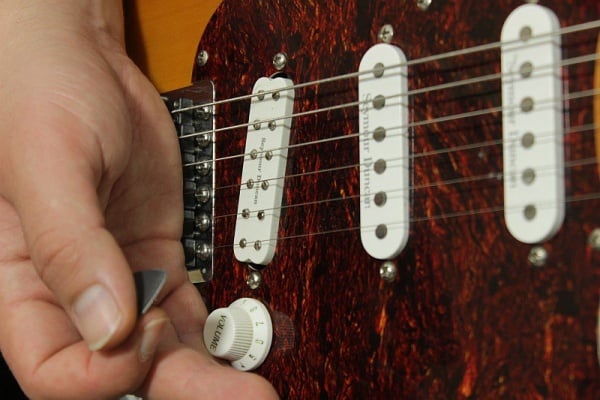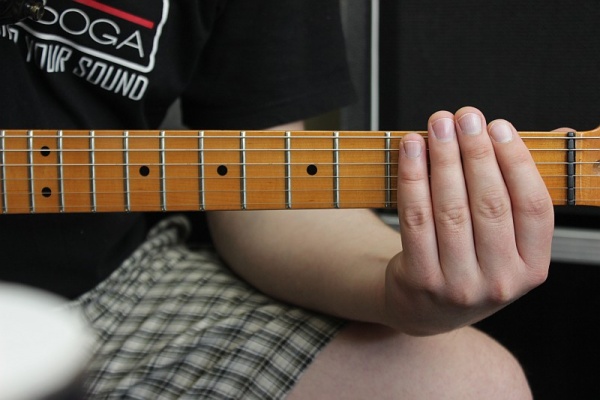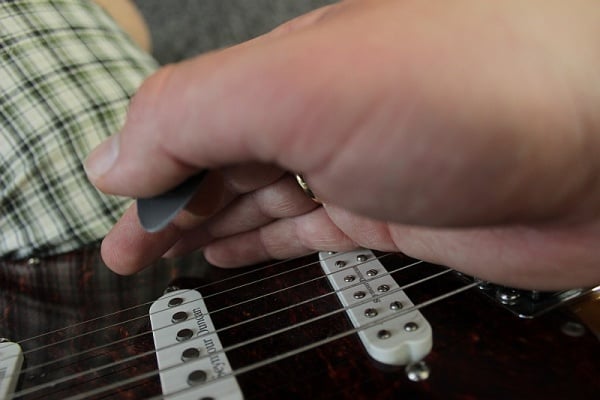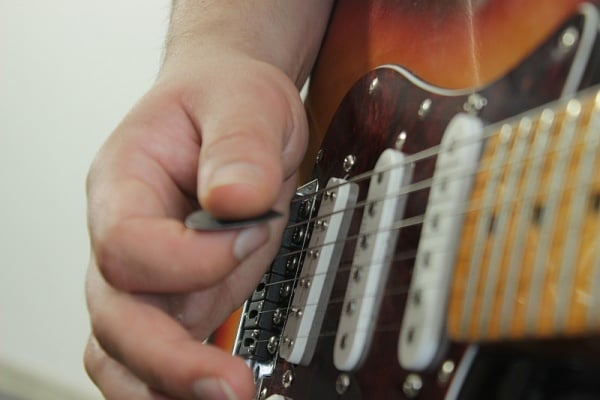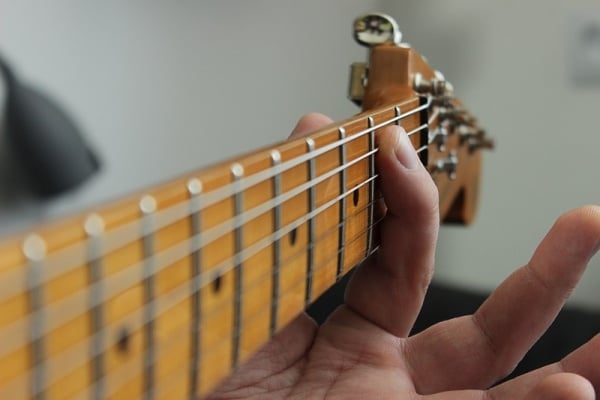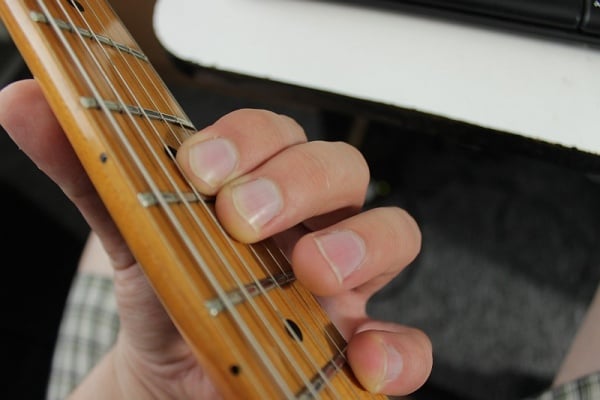Playing Clean How-To, Unwanted String Noise Removal Tips
| Line 32: | Line 32: | ||
1. Always roll down the volume knob, when you finish playing/have a longer break. I use a side of my right pinky to do that, and it works like automatic nosie gate. I do this even on the shorter breaks - for example: when the band plays silently and I have to use a little more of distortion to play long sustain notes for a change with breaks. Sometimes some of the buzz or hum can break through the fx noise gate. Why to risk if that's such a simple thing to fix at the stage of guitar itself | 1. Always roll down the volume knob, when you finish playing/have a longer break. I use a side of my right pinky to do that, and it works like automatic nosie gate. I do this even on the shorter breaks - for example: when the band plays silently and I have to use a little more of distortion to play long sustain notes for a change with breaks. Sometimes some of the buzz or hum can break through the fx noise gate. Why to risk if that's such a simple thing to fix at the stage of guitar itself | ||
| + | |||
| + | [[Image:dar1.jpg|600px]] | ||
| + | |||
| + | |||
| + | 2. Never move your hands whiile touching strings in the breaks. It causes scratching noise or a naturall ground buzz (if you leave all strings untouched for a moment). Try to hold your hands still and rest the both on the strings, without pressing, but softly touching the strings | ||
| + | |||
| + | [[Image:dar2.jpg|600px]] | ||
| + | |||
| + | [[Image:dar3.jpg|600px]] | ||
| + | |||
| + | 3. Rest your right palm on the low strings, while you play on the high strings. Lower strings tend to vibrate and ring under notes of solo we play (for example). You may not be able to hear this on the clean tone but on the distortion it's a regular issue. It's not enough to be able to not hit low strings while playing. They start to ring due to naturall vibration of guitar body, being also "infected" by other strings vibration, through the bridge and headstock. | ||
| + | |||
| + | [[Image:dar4.jpg|600px]] | ||
| + | |||
| + | |||
| + | 4. Flatten your left index finger. This one is an excellent, natural noise gate. It can mute every string below the one, it's pressing. Shape it just like with baree chords. Keep this finger in touch with the strings through all the lick/pattern/riff you play. This way you can play some riff stuff and hit even all of 6 strings, while hearing only those, which are being pressed. IT gives a lot of comfort for the right hand. You don't have to focus it's motion on the very narrow range of just those strings want to sound. Muted strings will add some more percussive flavour, so the profit is not only at the stage of muting unwanted strings. | ||
| + | |||
| + | [[Image:dar5.jpg|600px]] | ||
| + | |||
| + | |||
| + | 5. Use a tip of any left hand finger, to mute one string above the one you play. When You hold particular shape, You can use a tip of any finger to softly touch one string above. This is additional support for right hand muting. Why? It's hard to precisely rest the palm the way it will mute all unsed low strings, and at the same time will leave other strings fully open. Using this trick makes you able to leave "one string gap" between muted low strings and played high strings. This gap is fixed by left hand so essentially no string aside the one we played, is being left untouched. | ||
| + | |||
| + | [[Image:dar6.jpg|600px]] | ||
Revision as of 10:16, 27 June 2016
An Article by Darius Wave
Introduction
Hey guys (and girls) ![]()
Today I would like to share some tips with You. Those are tips I try to show in my lessons, because I believe they're critical, if You want to sound like a pro. This time I wanted to share them with our community through the forum.
If we look at what "Playing clean" is exactly, we realize it's a summary of a few different ascpets, like precise timing, even tone, consistent picking, correct pitch at bends and vibrato. Each of them takes time to master at pro level, yet there is one especially important in my opinion. Why so speciall? It's a pack of good habits, every guitar player should build since the very first days of playing. As the word says...those are habits so once you get them, you just play, never thinking about "how to". Those are...
Noise removal habits
In playing any instrument, silence is same important as the notes we play. Electric guitar with distortion needs a speciall care in this case, because distortion boosts all unwanted noises. For professinals it's critical to be able to keep your instrument 100% silent in all the breaks/pauses or the spots it's simply not involved in the arrange.
Good muting habits are not only the case of breaks but essentially...all the time we play as well. Ringing low strings can affect the sustain of high notes for example. This means that very often we do have twice as much job to take care of unwanted strings, than to play the actuall note.
Making yourself to preapre both hands for natural muting at the stage of beginner education is something, that can save you years. It's easier to get some good habits from the basis, than replacing bad habits with new ones. There is only one way to make it reasonable fast...
Completely stop doing things the way you did before. Use only the new way, from now on
Yes. You need to say to yourself "I'm done with the old way". You can't just split things and use bad, old habits because things are easier (at least for now). You need to totally remove what has been done wrong, from Your playing. It will take more or less time for each of us, but there is no shortuct to pass this, and in most cases....there will be time of doubts and disappointment, cased by lack of ability to play wlll things, we were used to consider as done/learned.
Let me introduce You to a few things/habits I have got naturally in the process of learning to play the guitar. I had to analyze my playing to help other people fix some issues. I thought I would be glad if someone could show me back then...i guess things will progress even faster.
1. Always roll down the volume knob, when you finish playing/have a longer break. I use a side of my right pinky to do that, and it works like automatic nosie gate. I do this even on the shorter breaks - for example: when the band plays silently and I have to use a little more of distortion to play long sustain notes for a change with breaks. Sometimes some of the buzz or hum can break through the fx noise gate. Why to risk if that's such a simple thing to fix at the stage of guitar itself
2. Never move your hands whiile touching strings in the breaks. It causes scratching noise or a naturall ground buzz (if you leave all strings untouched for a moment). Try to hold your hands still and rest the both on the strings, without pressing, but softly touching the strings
3. Rest your right palm on the low strings, while you play on the high strings. Lower strings tend to vibrate and ring under notes of solo we play (for example). You may not be able to hear this on the clean tone but on the distortion it's a regular issue. It's not enough to be able to not hit low strings while playing. They start to ring due to naturall vibration of guitar body, being also "infected" by other strings vibration, through the bridge and headstock.
4. Flatten your left index finger. This one is an excellent, natural noise gate. It can mute every string below the one, it's pressing. Shape it just like with baree chords. Keep this finger in touch with the strings through all the lick/pattern/riff you play. This way you can play some riff stuff and hit even all of 6 strings, while hearing only those, which are being pressed. IT gives a lot of comfort for the right hand. You don't have to focus it's motion on the very narrow range of just those strings want to sound. Muted strings will add some more percussive flavour, so the profit is not only at the stage of muting unwanted strings.
5. Use a tip of any left hand finger, to mute one string above the one you play. When You hold particular shape, You can use a tip of any finger to softly touch one string above. This is additional support for right hand muting. Why? It's hard to precisely rest the palm the way it will mute all unsed low strings, and at the same time will leave other strings fully open. Using this trick makes you able to leave "one string gap" between muted low strings and played high strings. This gap is fixed by left hand so essentially no string aside the one we played, is being left untouched.



